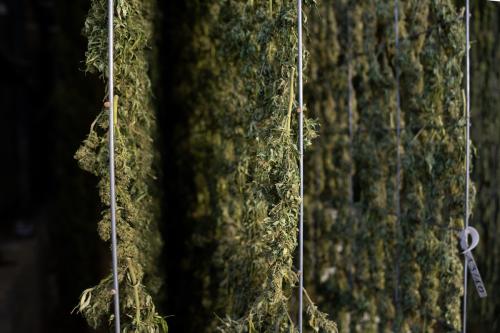With medical and recreational cannabis legalized in numerous states, the demand for cannabis products has skyrocketed. One very well-known fact about commerce and free enterprise is that where there is a necessity and a demand, growth and innovation are not too far behind. This can be seen happening right now when it comes to innovations for cannabis processing equipment.
Is there a significant difference between cannabis and hemp? What are the benefits of specialized cannabis and hemp processing equipment?
Let's dive into the answers to these questions and more below!
Hemp vs Cannabis – What's The Difference?
Is there actually a real difference between cannabis products and hemp products?
Even if you have just a passing familiarity with cannabis product manufacturing, you've probably come across numerous mentions of "hemp", "cannabis", and "marijuana". Likewise, it is also not uncommon to see uninformed individuals (and even some organizations) use these terms interchangeably – which can add to the confusion of whether there really is a difference between them.
The truth is that there are clear distinctions between these terms — from a scientific viewpoint, a legal perspective, and a business vantage as well.
The Scientific and Legal Distinctions Between Cannabis, Hemp, and Marijuana
Scientifically speaking, cannabis actually refers to a genus of plants, which includes the species cannabis Sativa and cannabis Indica.
In a legal sense, the distinction between hemp and marijuana is made through their cannabinoid content – more specifically their THC content. THC or tetrahydrocannabinol is the primary chemical in cannabis that is associated with its psychoactive properties, i.e. the "high".
To put it simply, hemp is legally defined as cannabis that has a THC content (by dry weight) of 0.3 percent or less. Anything else with a higher percentage of THC content than that is legally classified as marijuana.
So Why Do People Talk about Hemp vs Cannabis Then?
As you may have picked up from the scientific and legal definitions above, cannabis is technically the umbrella term that both hemp and marijuana fall under.
Why then does virtually every company in the industry fail to mention marijuana products and instead mention hemp and cannabis products?
It's due to generations of anti-marijuana propaganda and historic controversies related to the word itself. These have led to the term "marijuana" being mostly phased out of the industry.
The word cannabis is now being used in its place – eliminating a lot of the confusion and negative stigma as a result.
In summary:
Cannabis products have a THC content of more than 0.3 percent and may have noticeable psychoactive effects.
Hemp products have 0.3 percent or less THC content. They will impart negligible psychoactive effects and will not get you "high." In addition to this, hemp products usually have a higher concentration of CBD (cannabidiol) which further counteracts any potential psychoactive effects from occurring.
Examples of Hemp Products
The hemp industry can be divided into two distinct subcategories; the first being industrial hemp products and the second being hemp health and food products. Here are some common examples of both:
Industrial Hemp Products
- Paper
- Textiles (clothing, home furnishings, etc.)
- Rope
- Biofuel
- Plastics
- Building materials
Hemp Health and Food Products
- Raw seeds
- Milk
- Flour
- Infused drinks
- Oil
- Balms and lotions
Examples of Cannabis Products
Cannabis products are largely focused on consumption as a result of their relatively high THC content compared to hemp. Some common examples of cannabis products include:
- Flower
- Concentrates and extracts
- Vape cartridges
- Edibles (solid and liquid)
- Topical goods (oils, lotions, balms, etc.)
A Quick Overview of the Processing of Cannabis Sativa Plants
As you may have already guessed, there isn't a "one size fits all" solution when it comes to the processing of cannabis plants. One of the most notable reasons for this is the fact that cannabis plants are relatively "delicate" compared to a lot of other plants that have processing industries built around them.
That being said, the most influential reason for the wide variance in cannabis processing equipment is the fact that different parts of the plant require different processing methods.
Here are quick overviews of the two most notable examples.
Flowers and Seeds
The flowers of the cannabis plant are informally referred to as "buds" – although this is after they have been properly processed. These dried clumps are what first pop into most of our minds when cannabis is mentioned and this is usually where the highest concentration of THC can be found in the plant. On the other hand, the seeds contain very little cannabinoids (THC, CBD, etc.); however, they do have high nutritional value.
The seeds and flowers are the two most delicate parts of cannabis plants, so they require extra care during processing. Cannabis processing equipment that is targeted towards these parts of the plant needs to be precise, low impact, and low speed to maintain the integrity of the materials.
Stalks
The stalks of the plant are primarily used for the creation of industrial hemp products. So, as one would expect, it is not necessary to be as meticulous in processing these parts.
The initial phase of industrial hemp processing focuses on decortication – the separation of the fibers from the stalk's dense woody core.
Manufacturers also need industrial hemp processing equipment that can handle the scutching (separating any impurities from the necessary materials) and hackling processes (splitting, straightening, and cleaning of the fibers).
What Are Some Examples of Dry Bulk Materials That Are Extracted from Cannabis Plants?
Although it may not seem like it at first glance, there are actually quite a few different types of dry bulk materials that can be extracted from cannabis plants. Some of these dry bulk materials include:
- Dried flower buds
- CBD isolate
- Raw hemp seeds
- Hemp powders (from seeds, flowers, leaves, etc.)
- Dried extractives
- Retted stalks
What Are The Most Important Factors to Consider for The Storage and Conveyance of Hemp Materials?
One of the most important factors that need to be considered when it comes to the storage of hemp materials is that they need to be placed in secure and breathable containers (e.g. bulk bags, or FIBCs)
The environment is just as important though. Ideally, you want to make sure that both your unfinished hemp materials and industrial hemp products are stored in a dry and dimly lit environment. This is especially important because UV rays can easily cause cannabinoid content to degrade.
Drying raw hemp materials to a moisture content of 10% or less (naturally or through the use of specialized cannabis processing equipment) can drastically improve its storage lifespan.
Unique Products, Unique Solutions
Due to the ongoing changes in relevant legislation (and societal views), the cannabis industry has seen massive growth in recent years. This has led to an increasingly high demand for marijuana and hemp processing equipment.
Erie Technical Systems can design and create dry bulk handling solutions for manufacturers in up-and-coming hemp and cannabis industries. Our cannabis and hemp processing equipment can be specialized to meet your company's precise needs and processing methods.
Among them:
- UltimMAX™ Bulk Bag Unloaders
- Bulk Bag Fillers
- PalletMAX™ Pallet Dispensers
- FlexMAX® Flexible Screw Conveyors
- Vibratory Conveyors
Don't wait, contact Erie Technical Solutions and boost your productivity with your very own specialized cannabis and hemp processing equipment today!

